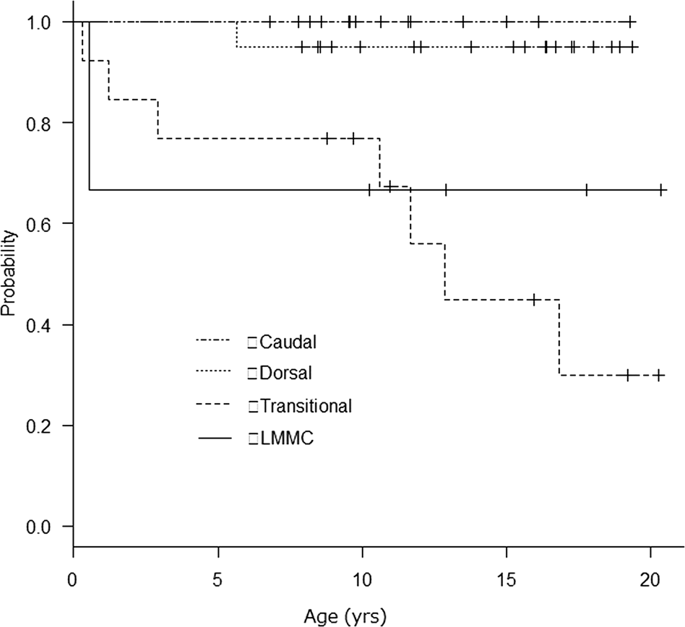Spinal Cord ( IF 2.2 ) Pub Date : 2019-11-26 , DOI: 10.1038/s41393-019-0385-y Chihiro Hayashi 1 , Yohei Kumano 1 , Daisuke Hirokawa 2 , Hironobu Sato 2 , Yuichiro Yamazaki 1

|
Study design
Cohort study.
Objectives
Long-term urological outcomes in patients with spinal lipoma after prophylactic tethered cord release (TCR) in infancy were investigated.
Setting
Children’s hospital in Yokohama, Japan.
Methods
Children under one year of age with spinal lipoma who underwent TCR between 1990 and 2010 were investigated. According to Arai’s classification, lipomas other than filar lipoma were classified into four types: caudal, dorsal, transitional, and lipomyelomeningocele. The level of the conus medullaris was divided into three categories: L3-5, L5/S1, and sacral. Urological outcomes, including the need for clean intermittent catheterization (CIC), urinary incontinence, presence of renal deterioration, and the need for bladder augmentation, were investigated by both lipoma type and level of the conus medullaris.
Results
Fifty-three patients met the inclusion criteria. The median follow-up period was 14.2 years (interquartile range 9.6–17.6 years). Of the 53 patients, ten (19%) were on CIC, and six (11%) were incontinent. Overall, two patients (4%) had renal deterioration detected by DMSA renal scan, and two (4%) needed augmentation cystoplasty. Of the lipoma types, transitional type showed the worst outcomes with respect to need for CIC (54%) and urinary incontinence (38%). There were no significant differences in renal deterioration and the rate of bladder augmentation by lipoma type. No urological outcomes were significantly associated with conus level.
Conclusions
Even after prophylactic TCR in infancy in children with spinal lipoma, 19% of patients needed CIC in long-term follow-up. Of the lipoma types, transitional type showed the worst outcomes with respect to need for CIC and urinary incontinence.
中文翻译:

婴儿期预防性解除束缚后脊髓脂瘤的长期泌尿外科结局:脂瘤解剖学在现实世界中的结局。
学习规划
队列研究。
目标
研究了婴儿期预防性栓系脊髓释放(TCR)后脊髓脂肪瘤患者的长期泌尿外科结局。
环境
日本横滨的儿童医院。
方法
研究对象是1990年至2010年间接受过TCR的一岁以下脊柱脂肪瘤儿童。根据新井的分类,除了丝状脂肪瘤以外,其他脂肪瘤分为四类:尾状,背状,过渡性和脂膜脑膜膨出。延髓的水平分为三类:L3-5,L5 / S1和骨。泌尿系结局包括脂肪瘤类型和延髓水平,都对泌尿外科结局进行了调查,包括是否需要进行清洁的间歇性导管插入术(CIC),尿失禁,是否存在肾脏恶化以及是否需要进行膀胱增大术。
结果
53名患者符合纳入标准。中位随访期为14.2年(四分位间距为9.6-17.6年)。在这53例患者中,有10例(19%)接受了CIC,有6例(11%)患有失禁。总体而言,有2例(4%)的患者通过DMSA肾脏扫描发现了肾脏恶化,而2例(4%)则需要进行膀胱扩大成形术。在脂肪瘤类型中,就CIC(54%)和尿失禁(38%)的需要而言,过渡型的结果最差。脂肪瘤类型在肾脏恶化和膀胱增大率方面无显着差异。没有泌尿外科结果与圆锥水平显着相关。
结论
即使在儿童脊柱脂肪瘤患儿接受了预防性TCR之后,长期随访中仍有19%的患者需要CIC。在脂肪瘤类型中,就需要CIC和尿失禁而言,过渡型显示出最差的结果。


























 京公网安备 11010802027423号
京公网安备 11010802027423号